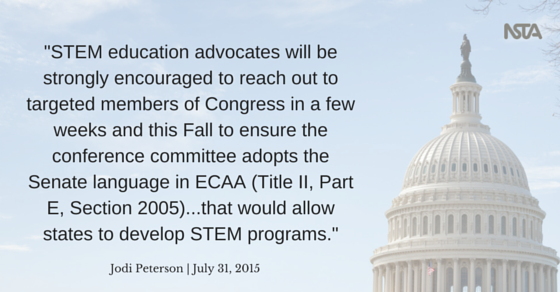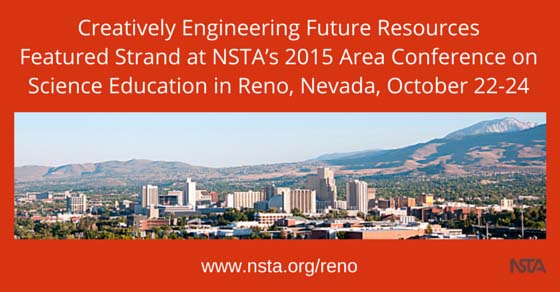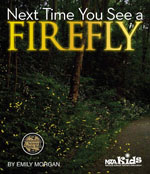What's the Role of Science Teachers in the New Conceptual Economy?
By Lauren Jonas, NSTA Assistant Executive Director
Posted on 2015-07-31
In the new conceptual economy, what skills will students need to acquire to walk into professional settings and tackle complex problems? A recent podcast Innovation Skills for the 21st Century Workplace (BFM 89.9) details the mindset that contributes to success–the ability to continually learn and improve. And it’s striking how well the skills and qualities needed align with the types of skills and qualities that can be honed in a science classroom–communication, collaboration, and adaptability, among others.
Creatively Teach Creativity
What can science teachers do? Science evangelist Ainissa Ramirez writes frequently about these types of skills. In a recent blog, Ramirez talks about Encouraging the Einstein and Edison in Everyone. And she gives simple, inexpensive ideas that any teacher can use. She explains how to nurture divergent thinking within students with an ordinary object like a key or a toothbrush. And, she recommends helping students learn to make connections among formerly unconnected topics. The takeaway? “Let’s be creative in the way that we teach children to be creative.”
Cultivate Collaboration
In Building Team Science, education professor Christine Royce gives ideas for team-building activities that have found their way into her classroom activities throughout the years:
Innovation in Action
So what does a classroom look like when innovative thinking is nurtured? Check out NSTA’s video series In the NGSS Classroom with Teacher Kristin Mayer. These 8 videos introduce science teachers to important strategies based on the Framework for K-12 Science Education and the Next Generation Science Standards (NGSS). The videos highlight the major shifts in science instruction, explore the new role of the teacher, and demonstrate new instructional strategies in the high school classroom.
At NSTA we’re lucky to work with and learn from innovative teachers every day. If you’ve got ideas to share with us, please let us know!
The mission of NSTA is to promote excellence and innovation in science teaching and learning for all.
Upcoming NSTA Conferences
2015 Area Conferences
2016 National Conference
2016 STEM Forum & Expo
Follow NSTA
In the new conceptual economy, what skills will students need to acquire to walk into professional settings and tackle complex problems? A recent podcast Innovation Skills for the 21st Century Workplace (BFM 89.9) details the mindset that contributes to success–the ability to continually learn and improve.
Legislative Update
House and Senate Leaders Begin Work to Reconcile Education Bills to Replace No Child Left Behind
By Jodi Peterson
Posted on 2015-07-31
Work has officially begun on the conference bill to resolve the differences in the House (H.R. 5, the Student Success Act) and Senate (S. 1177, the Every Child Achieves Act of 2015) bills to reauthorize the Elementary and Secondary Education Act and replace No Child Left Behind.
In a press statement issued on Thursday, July 30, the four education leaders in the House and Senate [House Education and the Workforce Committee Chairman John Kline (R-MN); Ranking Member Bobby Scott (D-VA); Senate Health, Education, Labor, and Pensions Committee Chairman Lamar Alexander (R-TN); and Senate Ranking Member Patty Murray (D-WA);] issued statements which expressed confidence and expressed hope that they can work together to produce a bicameral education bill.
As noted in an earlier NSTA Legislative blog post, on July 16 the U.S. Senate passed legislation to rewrite the No Child Left Behind Act. The bipartisan Senate bill, the Every Child Achieves Act (S.1177) passed 81-17 and contains a strong focus on STEM education. The partisan House bill, the Student Success Act (H.R. 5), passed on July 8, with 27 Republicans joining all House Democrats voting against the bill. The House bill goes much further than the Senate bill in reducing the federal role in education and does not include a dedicated program for STEM education.
Below are the key STEM provision in the Senate bill and other highlights from the House and Senate education bills. Congress adjourns at the end of July until after the Labor Day break (but education staff will continue to move the conference process along) so STEM education advocates will be strongly encouraged to reach out to targeted members of Congress in a few weeks and this Fall to ensure the conference committee adopts the Senate language in ECAA (Title II, Part E, Section 2005) listed below that would allow states to develop STEM programs.
Every Child Achieves Act (S. 1177) STEM Funding Provision (Title II, Part E, Section 2005)
Section 2005, which was added in a bipartisan Franken-Kirk Amendment during Committee consideration, establishes a program to provide each state with formula-based funding that would be used to support partnerships among local schools, businesses, universities, and non-profit organizations to improve student learning in the critical science, technology, engineering, and mathematics (STEM) subjects. Each state would choose how to spend and prioritize these funds, which can support a wide range of STEM activities from in-depth teacher training, to engineering design competitions, to improving the diversity of the STEM workforce. Activities supported through these funds include:
- Professional development for STEM educators
- Improving access and quality for STEM programs targeting high-need and underrepresented student populations
- Integrating in-school and out-of-school STEM education activities
- Supporting STEM-related competitions
- Facilitating the involvement of mid-career STEM professionals in educational activities
- Recruiting, retaining, and rewarding outstanding STEM educators through state-level STEM Master Teacher Corps programs
A funding level has not yet been established for this provision and is currently “such sums as required.” The funding authorization level for the current Math and Science Partnerships program at the Department of Education, which this provision would replace, is $450 million per year; however the appropriations for this program in FY2015 is $155 million.
Here are some other key highlights from the House and Senate passed education bills:
Testing and Standards: Both bills maintain current-law requirements for annual, statewide assessment of all students in grades 3–8 and at least once in high school, in both reading and math, as well as the requirement of a science assessment of all students in science at least once during elementary, middle, and high school. The bills also maintain the requirement that states adopt college- and career-ready standards in these subjects.
Accountability: Both bills eliminate NCLB’s adequate yearly progress requirements and require states to create their own accountability systems that annually measure student performance. The Senate bill goes further to require that state accountability systems include more than just test scores and also requires that states report how they assess school climate, discipline, homeless children, and early education. The House bill moves in the other direction and provides states with the option of not counting students that “opt-out” of federal testing against measures of test participation.
STEM Education: The Senate bill contains a program (Section 2005; see above) that would provide each state with dedicated funding to support improvements in the STEM subjects, with a strong focus on improving access and quality for high-need student populations. The House bill does not place any priority on STEM-related activities or provide any form of dedicated funding for STEM activities.
Support for Teachers and Teacher Quality: Both the House and Senate bills provide states with significant new flexibility in using Title II funds for teachers and school leaders. Both bills allow states to use federal funding to develop teacher evaluation systems, but it’s not a requirement. And the bills eliminate the definition of “highly qualified teacher” and instead let states decide what constitutes teacher quality.
Low-Performing Schools: Both bills eliminate the School Improvement Grant program, but include other federal funding directed at low-performing schools. Under the House bill, states would set aside 7% of their own Title I money for school improvement. States would have to intervene in Title I schools that aren’t performing well, but the bill doesn’t tell them how to do so, or how many schools to try to fix at a time. Under the Senate bill, states would have to monitor district turnarounds, and step in if low-performing schools weren’t getting any better. However, the federal government would be prohibited from telling states or districts how to fix struggling schools.
Jodi Peterson is Assistant Executive Director of Legislative Affairs for the National Science Teachers Association (NSTA) and Chair of the STEM Education Coalition. e-mail Jodi at jpeterson@nsta.org; follow her on Twitter at @stemedadvocate.
The mission of NSTA is to promote excellence and innovation in science teaching and learning for all.
Follow NSTA
Building Team Science
By Christine Royce
Posted on 2015-07-29
 Team building is something that any sports team undertakes; business teams participate in; as well as other professional areas focus on. The purpose of team building is to bring individuals together to develop interactions that enhance or increase the effectiveness of the team. So yes – it is important to develop and build skills in students that will help them be successful in Team Science situations.
Team building is something that any sports team undertakes; business teams participate in; as well as other professional areas focus on. The purpose of team building is to bring individuals together to develop interactions that enhance or increase the effectiveness of the team. So yes – it is important to develop and build skills in students that will help them be successful in Team Science situations.
The recently released report Enhancing the Effectiveness of Team Science focuses on how the pursuit of scientific endeavors has become “team science.” According to the report, team science is defined as “scientific collaboration, i.e., research conducted by more than one individual in an interdependent fashion, including research conducted by small teams and larger groups.” The reason for this team science approach is that scientific research is increasingly conducted by small teams and larger groups rather than individual investigators. However there are some drawbacks to this approach as well which include the challenges of collaboration which can slow these teams’ progress in achieving their scientific goals. How well a team works together is viewed as “team effectiveness (also referred to as team performance) [which is] [a] team’s capacity to achieve its goals and objectives. This capacity to achieve goals and objectives leads to improved outcomes for the team members (e.g., team member satisfaction and willingness to remain together), as well as outcomes produced or influenced by the team. In a science team or larger group, the outcomes include new research findings or methods and may also include translational applications of the research.”
In considering the these definitions, the idea of creating an environment that generates communication, collaboration, promotes creativity and innovation, as well as using critical thinking and problem solving skills is exactly what the college and career ready reports have been requesting for many years. In a second report titled Preparing 21st Century Students for A Global Society: An Educator’s Guide to the Four Cs there is a discussion of the importance for helping students become skilled in these 21st century skills that are needed in all aspects of our global world.
While solid science instruction is necessary to build student’s understanding of science, there is still a need to develop these other skills which often is not part of the actual curriculum. Therefore, a disclaimer – I am not sure where these activities would fit into your curriculum as they do not meet a national or state standard most likely. Furthermore, time is short and working together is something that one would think most students should learn early on in life. With that stated, the following are a few activities that have been used in various professional development activities attended that have found their way into classroom activities throughout the years.
Colored Broken Squares – A non-verbal problem solving activity that requires collaboration and cooperation as well as attention to detail.
Write It Do It – An older activity from the Science Olympiad that asks students to practice their writing skills in describing a structure and then switch with a partner who must follow the directions.
Tower of Cups – A problem solving activity that requires critical thinking and communication among team members.
Yes/No Conundrums – Requires students to ask yes/no questions to solve a riddle that is presented. Sometimes these are referred to by a commercial name as Stories with Holes.
These are but a few of the strategies that have found their way into my classroom regardless of the level over the years. Since helping students master the four Cs places them in a better position for the future, it is important to find the time to allow them time to develop communication, collaboration, critical thinking and problem solving and creativity and innovation. What activities or approaches can you add to the list as we collaborate together?
 Team building is something that any sports team undertakes; business teams participate in; as well as other professional areas focus on. The purpose of team building is to bring individuals together to develop interactions that enhance or increase the effectiveness of the team. So yes – it is important to develop and build skills in students that will help them be successful in Team Science situations.
Team building is something that any sports team undertakes; business teams participate in; as well as other professional areas focus on. The purpose of team building is to bring individuals together to develop interactions that enhance or increase the effectiveness of the team. So yes – it is important to develop and build skills in students that will help them be successful in Team Science situations.
Creatively Engineering Future Resources: Featured Strand at #NSTA 2015 Area Conference on Science Education in Reno, Nevada, October 22-24
By Lauren Jonas, NSTA Assistant Executive Director
Posted on 2015-07-28
Pose for a groupie shot with your science teacher friends this fall and you just may find the inventor of the “camera on a chip” in the photo! Cell phone camera inventor and Dartmouth Engineering Professor Eric Fossum will be the featured speaker for a special strand “Creatively Engineering Future Resources” at the NSTA 2015 Area Conference on Science Education, in Reno, October 22-24.
The featured presentation for this strand will be “Saturn to Smartphone Cameras: A Story of Science and Technology Innovation, on Thursday, October 22 3:30 PM – 4:30 PM, in the Reno-Sparks Convention Center, C1. Fossum will discuss the story of his invention of the CMOS image sensor and how that technology went from a NASA laboratory, through an entrepreneurial startup company, and into your smartphone. The critical role of science education in public schools and through supplemental programs will be highlighted.
What else will you learn about creatively engineering future resources? Below is a small sampling of other sessions on this topic:
- Using Project Based Learning to Teach Climate Change
- Healthy Land, Healthy Us! Informal/Formal Education Partnership
- Put the “E” in STEM!
- Recycled Goods as Inspiration in Learning: The Secret Life of Everyday Things
- Making a Better City
Want more? Check out more sessions and other events with the Reno Session Browser/Personal Scheduler. Follow all our conference tweets using #NSTA15, and if you tweet, please feel free to tag us @NSTA so we see it!
The mission of NSTA is to promote excellence and innovation in science teaching and learning for all.
Future NSTA Conferences
2015 Area Conferences
2016 National Conference
2016 STEM Forum & Expo
Follow NSTA
NSTA summer journals for K-12 teachers
By Mary Bigelow
Posted on 2015-07-26
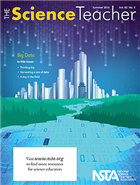 Add these journals to your summer reading!
Add these journals to your summer reading!
The Science Teacher: Big Data
As the editor says this month, “Scientific progress doesn’t result from simply accumulating data.” And data is definitely accumulating rapidly! Analyzing and interpreting data is one of the NGSS science and engineering practices, and how to organize, analyze, and interpret data (from students’ own investigations or from the work of others) and how to recognize valid conclusions from data are important if our students are to be informed citizens and potential scientists. (Career of the Month: Data Analyst).
It’s easy to find articles or news sites that summarize data and present an interpretation, but the editor continues: “…students can engage in the higher-order thinking involved in analyzing and interpreting large science datasets (big data) and designing their own inquiries to discover patterns and meaning in mountains of accessible data.” These data are collected by probes and investigators and are often streamed in real time. The featured articles in this edition focus on classroom strategies for investigations using secondary data.
- Thinking Big: Most students have had experience in data in their own investigations. But students and teachers also have access to large data sets via the Internet, from research projects and citizen science databases. The authors discuss the differences between local and large-scale data sets and how to transition to using “big” data in the classroom. The article has examples of strategies (provided in the Connections), a list of K-12 projects that provide big data, and suggestions for classroom projects.
One of the suggested projects that I am familiar with is NOAA’s Data in the Classroom. Each module has five levels of lessons ranging from teacher-presented ones to letting students explore the data to full-blown problem solving and invention. Each module shows the associated data in a variety of formats and guides the users through how to interpret it. There are “checkup” questions throughout, and teachers can download the materials.
- A Day in the Field introduces the term “secondary data”–data collected by others. Students studied a local estuarine system and shared their data with those collecting similar data at other locations. It was an authentic experience in using analysis tools such as mapping and spreadsheets. As the authors noted “Data analysis is about pattern recognition.”
- Harvesting a Sea of Data describes how students can study migration patterns using data from the Ocean Tracks research program. The project provides opportunities for students to study phenomena in faraway locations. (see also the Oceans of Data website)
[For more on the content that provides a context for these projects and strategies see the SciLinks websites for Birds, Telesccopes, Watersheds, Estuaries, Migration]
Continue for Science Scope and Science and Children.
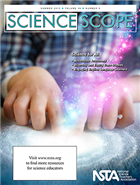 Science Scope: Science for All
Science Scope: Science for All
Strategies that help students with learning disabilities, students who are English Language Learners, or students with physical impairments have the added benefit of being appropriate for others. This was also the theme for the April issue of The Science Teacher, so we have a lot of resources on this topic in addition to these featured articles!
- Touching the Stars: Making Astronomy Accessible for Students With Visual Impairments addresses the question of how to help all students with subjects that rely heavily on visual information. The Skynet Junior Scholars online program includes online access to telescopes and data, a student-friendly interface to control telescopes, and instructional modules. The technology also can convert digital images to tactile models. The araticle includes a table of resources for accessible materials.
- The authors of Engineering Progressions in the NGSS Diversity and Equity Case Studies elaborate on the case studies that are part of the NGSS. “While the teaching strategies outlined in the case studies will work well with all students, they were specifically developed to address what classroom teachers can do to ensure that the NGSS is accessible to all students, particulary nondominant student groups.
- Collaborative Concept Maps: A Voice for All Science Learners has examples of how students of different academic levels can make connections and see the relationships between concepts. The authors provide photos of student concept maps created during an activity on adaptation and change over time.
- The Fish Weir: A Culturally Relevant STEM Activity shows how STEM practices can be integrated into lessons for Native American students (as well as others). Specifically, how do people adapt weirs to different environmental condition and migratory patterns. (If your students are not familiar with weirs, the article has several photographs of student-designed ones.
-
If you have students with learning disabilities in your classes, Supporting Science Access for All Students: Using Content Enhancements to Create Pathways to the Big Ideas discusses how to incorporate instructional strategies that make science activities more explicit and connected. This could benefit all students who struggle.
- This month’s Teacher’s Toolkit: “What’s Our Three-Word Claim?”: Supporting
English Language Learning Students’ Engagement in Scientific Argumentation describes three strategies to guide ELL students through a claim-evidence-reasoning lesson, using how antibiotics kill bacteria as the context.
- Tried and True: Fossils, Inquiry, and the English Language Learner concludes with the statement “With proper planning, language does not have to be a limitation to learning science.” The article describes well-planned activities related to an investigation of fossils.
[For more on the content that provides a context for these projects and strategies see the SciLinks websites for Antibiotics, Bacteria, Astronomy, Telescopes, Bird Adaptations, Fishes, Fossil Record, Populations, Communities, and Ecosystems]
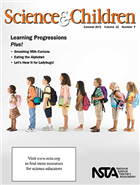 Science and Children: Learning Progressions Plus!
Science and Children: Learning Progressions Plus!
The NGSS provides information to support the development of learning progressions based on research. Students bring different backgrounds and skills to the classroom, so this issue intersects with the Science for All themes of other NSTA K-12 journals.
- Young children playing with clay is a familiar scene in pre-K schools (or it should be). The lesson in The Early Years: A Progression of Learning takes clay to a new level as students explore its properties, as well as learn to create. A similar type of progressing from parts and wholes to conservation of matter is described in Formative Assessment Probes: Snap Block.
- Eating the Alphabet describes an interdisciplinary kindergarten activity involving the sense of taste as students progress through the alphabet with familiar and unfamiliar foods (safety suggestions are provided).
- Dig Into Fossils! is a developmentally appropriate lesson for young children (K-2) in which they get hands-on experiences. For teacher background information, see Science 101: How Do You Date Fossils?
- Who knew that the ubiquitous milk carton could be the focus of an engineerng design project? The activities in Smashing Milk Cartons introduce students to the ideas of recycling and composting and to designing solutions to a school-wide, real-world problem. More engineering applications can be found in Engineering Encounters: You and Your Students as Green Engineers.
- STEM learning does not have to be limited to the classroom. Families Learning Together can be a powerful way to foster a progression of lifelong learning.
- Let’s Hear It for Ladybugs! as student learn about life cycles.
- The two lessons in Teaching Through Trade Books: All the Water in the World illustrate how lessons at the K-2 and 3-5 grade levels can focus on the topic at different levels of sophistication.
[For more on the content that provides a context for these projects and strategies see the SciLinks websites for Watersheds, Water Underground, Fossils, Recycling, Composting, Life Cycles, Metamorphosis, Insects]
 Add these journals to your summer reading!
Add these journals to your summer reading!
The Science Teacher: Big Data
7 Science Facts #NSTA Learned on Twitter This Week
By Lauren Jonas, NSTA Assistant Executive Director
Posted on 2015-07-25
Twitter is a treasure trove for news. These tweets caught our eye at NSTA recently, and they could surely be useful conversation starters in the classroom. Read on, and share the stories that caught your eye this week!
1. Kids love chasing fireflies, and scientists have been chasing the secret to how they glow for 60 years.
How do fireflies glow? Mystery solved after 60 years: http://t.co/ubgknu0xs8
— National Geographic (@NatGeo) July 24, 2015
2. Ice cream dates back to biblical times!
Did you know ice cream dates back to biblical times? #PBSIceCreamWeek (via @PBSFood): http://t.co/CzbatTIecH
— PBS Teachers (@pbsteachers) July 25, 2015
3. Returning humans to the moon could cost 90% less than expected, bringing estimated costs down to $10 billion.
Looks like colonizing the moon could be 90 percent cheaper than we thought http://t.co/426qm7Ajxh pic.twitter.com/ZB0ALHIXgu
— Popular Science (@PopSci) July 25, 2015
4. CRISPR. All the cool kids are talking about it, and here’s why:
CRISPR has “promised direct assess to the source code of life.” Your Saturday #longread, from @Wired: http://t.co/nkxvRSX1jx
— NOVA (@novapbs) July 25, 2015
5. A major earthquake will cause plenty of destruction along the West Coast, but it won’t look like it does in the movies.
What will really happen when San Andreas unleashes the big one? http://t.co/C00GW99dzP pic.twitter.com/BEzoQUyNH0
— Ask Smithsonian (@AskSmithsonian) May 29, 2015
6. Restless, wandering minds are capable of enormous creativity.
Are you bored? Guess what, that’s a good thing because you’ll be more creative. http://t.co/QBKo8RrgQa
— Ainissa Ramirez (@ainissaramirez) July 25, 2015
7. Astronaut Scott Kelly is craving a Philly cheese steak. (Isn’t everyone?)
#Goodmorning #Philadelphia! One of your cheese steaks would be great 4 months into my #YearInSpace pic.twitter.com/IQ9HjZcInV
— Scott Kelly (@StationCDRKelly) July 25, 2015
The mission of NSTA is to promote excellence and innovation in science teaching and learning for all. Follow @NSTA on Twitter to see more stories like these and get the science education resources you need.
Twitter is a treasure trove for news. These tweets caught our eye at NSTA recently, and they could surely be useful conversation starters in the classroom. Read on, and share the stories that caught your eye this week!
1. Kids love chasing fireflies, and scientists have been chasing the secret to how they glow for 60 years.
How do fireflies glow? Mystery solved after 60 years: http://t.co/ubgknu0xs8
What are science teachers reading this summer?
By Claire Reinburg
Posted on 2015-07-23
Browse this month’s most popular books, e-books, children’s trade books, and journal articles on NSTA’s website. Between now and August 14, 2015, save 10% on NSTA Press and NSTA Kids books or e-books by entering promo code SUMMER at checkout from the online Science Store.
Most Popular NSTA Press Books
Argument-Driven Inquiry in Life Science: Lab Investigations for Grades 6–8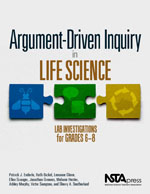
Picture-Perfect Science Lessons, Expanded 2nd Edition: Using Children’s Books to Guide Inquiry, 3–6
Translating the NGSS for Classroom Instruction
Uncovering Student Ideas in Life Science, Volume 1: 25 New Formative Assessment Probes
The Power of Questioning: Guiding Student Investigations
Most Popular NSTA Press e-Books
Solar System (enhanced e-book)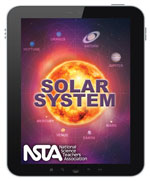
Uncovering Student Ideas in Science, Volume 2: 25 More Formative Assessment Probes (e-book)
Earth Science Success, 2nd Edition: 55 Tablet-Ready, Notebook-Based Lessons (e-book)
Argument-Driven Inquiry in Biology: Lab Investigations for Grades 9–12 (e-book)
The BSCS 5E Instructional Model: Creating Teachable Moments (e-book)
Most Popular NSTA Kids Books
How Does the Wind Blow? I Wonder Why
How Tall Was Milton? I Wonder Why
Up, Up in a Balloon: I Wonder Why
Most Popular Journal Articles
Dig Into Fossils! (elementary)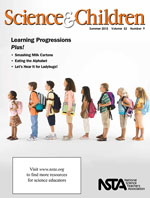
Thinking Big (high school)
The Next Generation Science Standards: Where Are We Now and What Have We Learned? (middle school)
Collaborative Concept Maps: A Voice for All Science Learners (middle school)
A Day in the Field (high school)
The mission of NSTA is to promote excellence and innovation in science teaching and learning for all.
Follow NSTA
Browse this month’s most popular books, e-books, children’s trade books, and journal articles on NSTA’s website. Between now and August 14, 2015, save 10% on NSTA Press and NSTA Kids books or e-books by entering promo code SUMMER at checkout from the online Science Store.
Expanding understanding, resources for discussions about gender
By Peggy Ashbrook
Posted on 2015-07-23
 Young children’s imaginative play often includes creating family groups with toy animals or dolls, and role-playing with housekeeping and dress-up materials. They recreate the relationships they experience or know of from books and other media. As a “mother dog,” a child will tell the “puppies” to follow her. Children who behave out of character, such as sitting at a table instead of curling up on a blanket on the floor, get called out by other children–“Dogs don’t sit at tables!” Children who wear clothing not designed to go together may be told, “Doctors don’t wear hardhats!”
Young children’s imaginative play often includes creating family groups with toy animals or dolls, and role-playing with housekeeping and dress-up materials. They recreate the relationships they experience or know of from books and other media. As a “mother dog,” a child will tell the “puppies” to follow her. Children who behave out of character, such as sitting at a table instead of curling up on a blanket on the floor, get called out by other children–“Dogs don’t sit at tables!” Children who wear clothing not designed to go together may be told, “Doctors don’t wear hardhats!”  Sometimes children’s lack of experience may be revealed in their play. I don’t hear “Girls can’t be doctors” these days but I have heard “Only boys can drive the truck,” in spite of the role models available today.
Sometimes children’s lack of experience may be revealed in their play. I don’t hear “Girls can’t be doctors” these days but I have heard “Only boys can drive the truck,” in spite of the role models available today.
Just as we work to expand children’s understanding of when the Moon is visible (not only at night as portrayed in most media but in the daytime too), we can expand children’s understanding of gender roles in careers, friendships, and family. Just as we create a safe environment for children to voice their questions about science content, we maintain that safe environment for all questions.
Some resources for these discussions include:
- Bringing Boys and Girls Together: Supporting Preschoolers’ Positive Peer Relationships by Hillary Manaster and Maureen Jobe. Young Children. November 2012.
http://www.naeyc.org/yc/files/yc/file/201211/Manaster.pdf
- Every Color on the Canvas: Using Art to Explore Preschoolers’ Understanding of Differences by Meagan K. Shedd and Rebecca L. Coyner. July 2015. Young Children. 70 (3): 84-87
- U.S. Dept of Health and Human Services, Administration for Families and Children. Partnering with LGBT families in Early Head Start and Head Start by Angie Godfrey. June 18, 2013.
http://www.acf.hhs.gov/blog/2013/06/partnering-with-lgbt-families-in-early-head-start-and-head-start
- Welcoming Schools, a resource for educators for tools to address bias-based name-calling and bullying, and to meet the needs of students whose family structures are not well represented or included in school environments.
http://www.welcomingschools.org/pages/who-can-marry-whom-inclusive-conversations-about-marriage/
Any conversations that encourage critical thinking and using evidence from observations help children build their understanding of the world. Read about moon misconceptions in children’s literature in “The Moon in Children’s Literature: How to avoid the pitfalls of introducing misconceptions when reading about the Moon,” by Kathy Cabe Trundle and Thomas H. Troland in the October 2005 issue of Science and Children.
 Young children’s imaginative play often includes creating family groups with toy animals or dolls, and role-playing with housekeeping and dress-up materials. They recreate the relationships they experience or know of from books and other media. As a “mother dog,” a child will tell the “puppies” to follow her.
Young children’s imaginative play often includes creating family groups with toy animals or dolls, and role-playing with housekeeping and dress-up materials. They recreate the relationships they experience or know of from books and other media. As a “mother dog,” a child will tell the “puppies” to follow her.
A graphic organizer for writing
By Mary Bigelow
Posted on 2015-07-22
 When I ask students to write about a topic, most try to submit a collection of copy-and-paste paragraphs. I’m looking for strategies to help students create original writing. —H., Georgia
When I ask students to write about a topic, most try to submit a collection of copy-and-paste paragraphs. I’m looking for strategies to help students create original writing. —H., Georgia
Before the Internet, when students were assigned to write on a topic, they went to the library, found the topic in an encyclopedia, and copied enough words to meet the length criteria. Fast-forward to today’s world of online searching, Wikipedia, and electronic copy/paste and you have updated the situation.
In the old days, as students copied by hand, they at least had to look at the words. I recently watched a biology student completing a vocabulary activity on cells. With his laptop he copied and pasted a definition of nucleus—as the center of an atom composed of protons and neutrons!
Synthesizing information from several sources is a useful process. But it might not be an intuitive one for students. When I was teaching middle school, each student created a report on an endangered animal. Even though I told the students I wanted to see their own writing, I still had many copy-and-paste versions. It was clear that students needed some guidance and examples of how to gather and use information from several sources.
Although my colleagues at the high school level swore by index cards and outlines for preparing reports, I knew these would be hard for many seventh graders. My classes included special education students, so I asked the special education teacher if she had any suggestions for helping students organize information and use what they find.
My colleague introduced me to the idea of using a “matrix” to help break down the task and provide a graphic organizer for the information. We worked together to design a template, realizing that what was helpful for special needs students would be helpful for all.
It was a one-page document, with a table. The column headers were blank for students to identify the sources they used (the librarian helped explain how to document the sources). The row labels were for characteristics of the animal. We brainstormed these labels in class. Most classes came up with the same ones, but it gave students some input into the document. If they didn’t think of it, I suggested a row for “interesting facts.” (Here is an example of a Matrix–feel free to download and adapt!)
As students found information, they filled in a column for each source. They had questions: What if a source doesn’t have information for a box? (Put “N/A”—it shows the value of multiple sources.) I can’t fit everything into the box. (The size of the square means just a summary the facts–not a lot of writing.) It was another teachable moment when students realized that some sources had different information.
The effectiveness of this strategy became apparent when they started to write. This time, they looked at each row to summarize and elaborate on the topic. For students who weren’t sure how to start, I suggested opening with an interesting fact, writing one or two paragraphs for each row, and concluding with another interesting fact. It was an “aha” moment for students as they saw their original writing emerge. We did the writing in class, which took a few class periods. My colleague and I decided it was worth it when we saw the results.
One year, two students showed me how they took the matrix idea and used it to organize their own notes on arthropods. The column headings were classes of arthropods and the row labels were characteristics such as number of legs. I asked them to explain why this was more helpful than an outline or text paragraphs. They said that it was really easy to see how the classes of arthropods were similar and how they were different—quite an observation! I also used this strategy with high school students, and the use of matrix organizers morphed into my dissertation topic.
Both parts of the process—notetaking and writing—can be done electronically. The final document could be a written report, presentation slides, a foldable, or infographic.
I ran into a former student at a social event in our community. We reminisced about school, and he said that he still had his endangered animal report and read it to his kids!
Legislative Update
Senate Passes Legislation to Overhaul No Child Left Behind
By Jodi Peterson
Posted on 2015-07-20
Fourteen years after it was first signed into law and seven years after it expired, the U.S. Senate passed legislation on Thursday, July 16 to overhaul the Elementary and Secondary Education Act–commonly known as No Child Left Behind–by a vote of 81 to 17.
The Every Child Achieves Act, the bipartisan agreement by Senate education committee Chairman Lamar Alexander (R-TN) and Ranking Member Patty Murray (D-WA), contains a significant program for STEM education and retains the requirement that states continue testing in math and science. Overall the bill reduces the role of the federal government and gives states the flexibility not found under No Child Left Behind.
On July 8, the House of Representatives passed the largely partisan Student Success Act (H.R. 5) their bill to reauthorize the Elementary and Secondary Education Act.
Next up is work on the final House-Senate conference agreement, as education leaders work to find a compromise between many of the differing issues/ policies (greater accountability, students opting out of testing, Title I portability) in the two bills and produce a final bill acceptable to their respective caucuses and to the White House. Chairman Alexander is quoted as saying he would like to get a bill to the president this fall.
STEM advocates are gearing up now to ensure that the final bill will retain the Senate’s strong STEM focus. Watch for upcoming issues of NSTA Express and special NSTA Legislative Alerts to find out how you can help ensure STEM education remains a priority in the final federal education law.
- Read the Education Week blog on passage of Every Child Achieves Act.
- Read the Senate press release on passage of the bill.
- Read the AP article on the bill.
Jodi Peterson is Assistant Executive Director of Legislative Affairs for the National Science Teachers Association (NSTA) and Chair of the STEM Education Coalition. e-mail Jodi at jpeterson@nsta.org; follow her on Twitter at @stemedadvocate.
The mission of NSTA is to promote excellence and innovation in science teaching and learning for all.
Follow NSTA
Fourteen years after it was first signed into law and seven years after it expired, the U.S. Senate passed legislation on Thursday, July 16 to overhaul the Elementary and Secondary Education Act–commonly known as No Child Left Behind–by a vote of 81 to 17.



